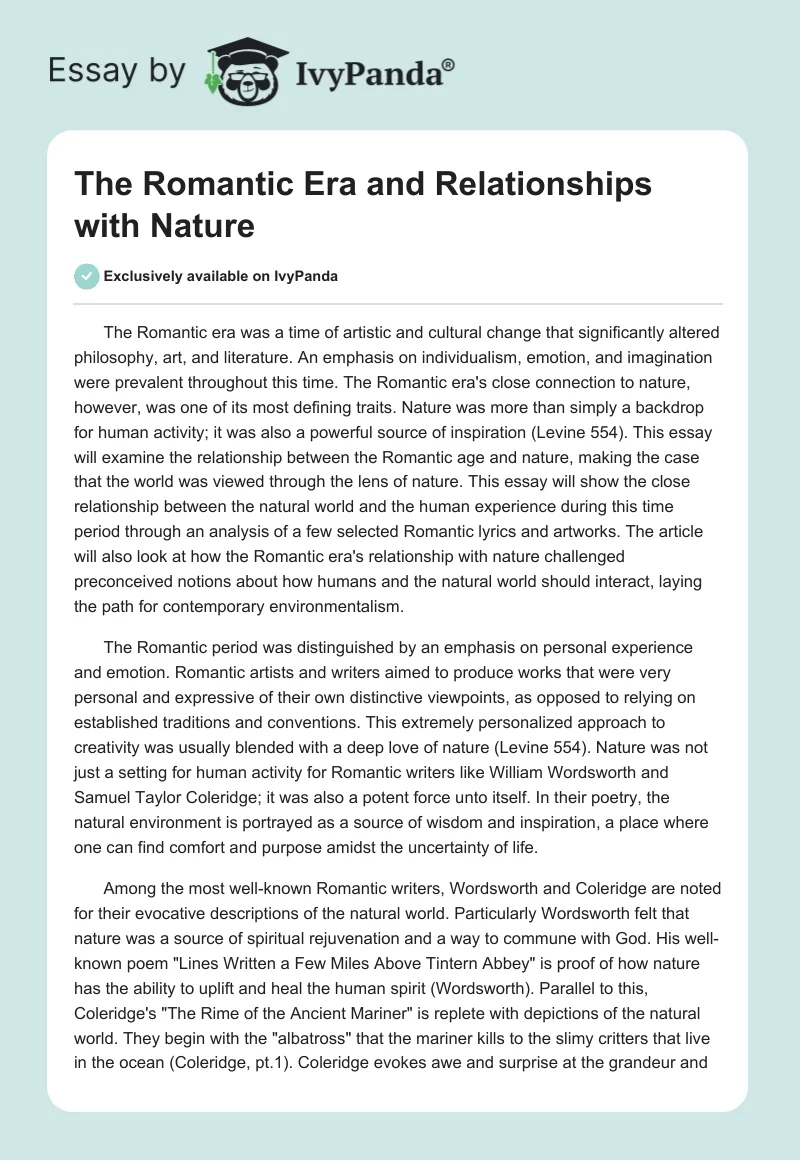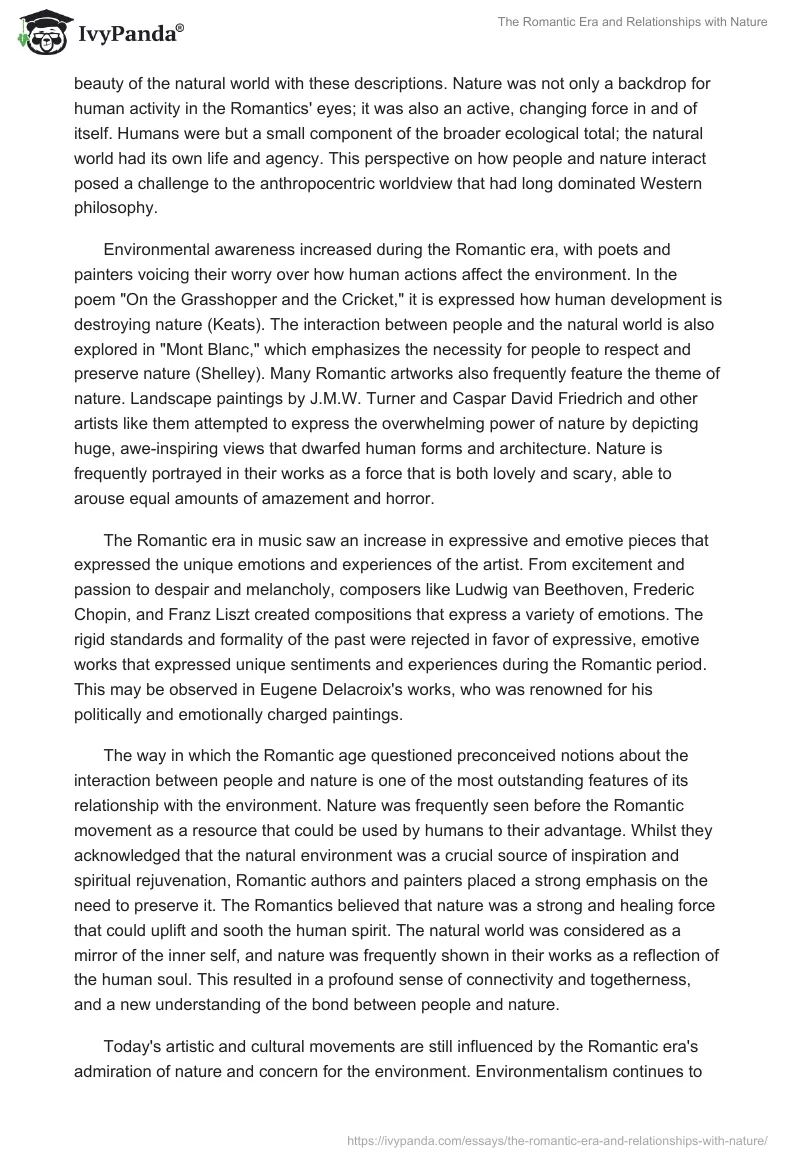The Romantic era was a time of artistic and cultural change that significantly altered philosophy, art, and literature. An emphasis on individualism, emotion, and imagination were prevalent throughout this time. The Romantic era’s close connection to nature, however, was one of its most defining traits. Nature was more than simply a backdrop for human activity; it was also a powerful source of inspiration (Levine 554). This essay will examine the relationship between the Romantic age and nature, making the case that the world was viewed through the lens of nature. This essay will show the close relationship between the natural world and the human experience during this time period through an analysis of a few selected Romantic lyrics and artworks. The article will also look at how the Romantic era’s relationship with nature challenged preconceived notions about how humans and the natural world should interact, laying the path for contemporary environmentalism.
The Romantic period was distinguished by an emphasis on personal experience and emotion. Romantic artists and writers aimed to produce works that were very personal and expressive of their own distinctive viewpoints, as opposed to relying on established traditions and conventions. This extremely personalized approach to creativity was usually blended with a deep love of nature (Levine 554). Nature was not just a setting for human activity for Romantic writers like William Wordsworth and Samuel Taylor Coleridge; it was also a potent force unto itself. In their poetry, the natural environment is portrayed as a source of wisdom and inspiration, a place where one can find comfort and purpose amidst the uncertainty of life.
Among the most well-known Romantic writers, Wordsworth and Coleridge are noted for their evocative descriptions of the natural world. Particularly Wordsworth felt that nature was a source of spiritual rejuvenation and a way to commune with God. His well-known poem “Lines Written a Few Miles Above Tintern Abbey” is proof of how nature has the ability to uplift and heal the human spirit (Wordsworth). Parallel to this, Coleridge’s “The Rime of the Ancient Mariner” is replete with depictions of the natural world. They begin with the “albatross” that the mariner kills to the slimy critters that live in the ocean (Coleridge, pt.1). Coleridge evokes awe and surprise at the grandeur and beauty of the natural world with these descriptions. Nature was not only a backdrop for human activity in the Romantics’ eyes; it was also an active, changing force in and of itself. Humans were but a small component of the broader ecological total; the natural world had its own life and agency. This perspective on how people and nature interact posed a challenge to the anthropocentric worldview that had long dominated Western philosophy.
Environmental awareness increased during the Romantic era, with poets and painters voicing their worry over how human actions affect the environment. In the poem “On the Grasshopper and the Cricket,” it is expressed how human development is destroying nature (Keats). The interaction between people and the natural world is also explored in “Mont Blanc,” which emphasizes the necessity for people to respect and preserve nature (Shelley). Many Romantic artworks also frequently feature the theme of nature. Landscape paintings by J.M.W. Turner and Caspar David Friedrich and other artists like them attempted to express the overwhelming power of nature by depicting huge, awe-inspiring views that dwarfed human forms and architecture. Nature is frequently portrayed in their works as a force that is both lovely and scary, able to arouse equal amounts of amazement and horror.
The Romantic era in music saw an increase in expressive and emotive pieces that expressed the unique emotions and experiences of the artist. From excitement and passion to despair and melancholy, composers like Ludwig van Beethoven, Frederic Chopin, and Franz Liszt created compositions that express a variety of emotions. The rigid standards and formality of the past were rejected in favor of expressive, emotive works that expressed unique sentiments and experiences during the Romantic period. This may be observed in Eugene Delacroix’s works, who was renowned for his politically and emotionally charged paintings.
The way in which the Romantic age questioned preconceived notions about the interaction between people and nature is one of the most outstanding features of its relationship with the environment. Nature was frequently seen before the Romantic movement as a resource that could be used by humans to their advantage. Whilst they acknowledged that the natural environment was a crucial source of inspiration and spiritual rejuvenation, Romantic authors and painters placed a strong emphasis on the need to preserve it. The Romantics believed that nature was a strong and healing force that could uplift and sooth the human spirit. The natural world was considered as a mirror of the inner self, and nature was frequently shown in their works as a reflection of the human soul. This resulted in a profound sense of connectivity and togetherness, and a new understanding of the bond between people and nature.
Today’s artistic and cultural movements are still influenced by the Romantic era’s admiration of nature and concern for the environment. Environmentalism continues to be a significant social and political problem, and many artists continue to examine the interaction between people and the natural world. A reminder of the value of preserving and safeguarding the natural world for future generations can be found in the legacy of the Romantic era. The emphasis on nature, individualism, emotion, and imagination throughout this time continues to have a significant impact on modern art and society. The Romantic era’s legacy serves as a reminder of the ongoing ability of art to record the human experience, whether via the continued exploration of nature’s beauty and majesty or the expression of unique sentiments and experiences.
In conclusion, the Romantic period was distinguished by a profound and intricate connection to nature. The natural world served as a source of creativity, knowledge, and awe-inspiring power for Romantic poets and painters. This paper has shown that the Romantic age was marked by its distinctive perspective on nature, one that has continued to impact artistic and cultural movements to this day by examining this relationship in a number of poems and paintings. The Romantics’ perspective on nature was a response to the effects of the Industrial Revolution on the natural world. They believed that urbanization and industrialisation were not only damaging people’s spiritual and emotional health, but also ruining the natural world. The Romantics therefore aspired to rediscover nature, to value its force and beauty, and to find inspiration and consolation there. They often personified nature in their works because they saw it as a living thing with its own agency and purpose.
Works Cited
Coleridge, Samuel. “The Rime of the Ancient Mariner.” Poetry Foundation, 1835, Web.
Keats, John. “On The Grasshopper and Cricket.” Poetry Foundation, 1884, Web.
Levine, Robert. The Norton Anthology of American Literature. W. W. Norton and Company, 2017.
Shelley, Percy. “Mont Blanc: Lines Written in the Vale of Chamouni.” Poetry Foundation, Web.
Wordsworth, William. “Lines Written a Few Miles Above Tintern Abbey.” The Reader, edited by Rachael Norris, Web.


